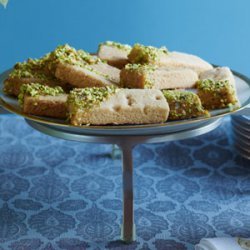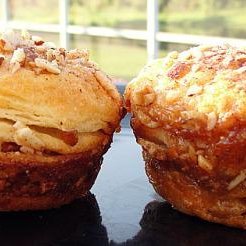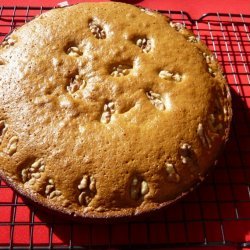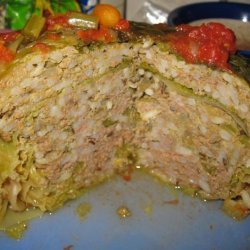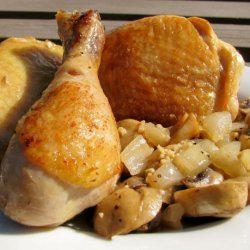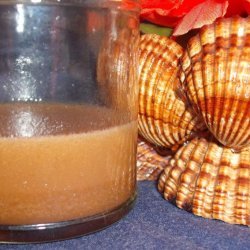Ingredients:
- green food color
- scant 9 oz (250 g) bittersweet chocolate, tempered, recipe follows
- scant 1/4 cup (50 g) butter
Directions:
- Place the almond paste on the work surface. Add the kirsch, pistachio paste, chopped pistachios and food color to the almond paste. The amount of green food color that you add is up to you, I usually add 1 to 2 drops. Knead until well combined. Roll the mixture into a 1-inch-thick diameter cylinder. Try to roll it as evenly as possible. Transfer the cylinder to a parchment paper covered baking sheet. Use a pastry brush dipped in the bittersweet chocolate to coat the cylinder. When the chocolate begins to set but has not hardened, turn the cylinders so you can paint the other side. You can make a thicker chocolate coating by repeating this process a few times. For the last coat, I tapped the chocolate filled pastry brush against the outside of the chocolate to give the candy a spiked texture. When the chocolate begins to set but has not hardened, use a sharp paring knife to slice the cylinder into 1-inch-thick slices. Allow the chocolate to set completely. Serve
- Jacques' tip: I used a pastry brush to coat the Branches in chocolate because it is a time saver and I like to see the green when the Branches are cut. You could also use a dipping fork and dip them one by one.
- Place the sugar, honey and water in a saucepan and bring to a strong boil. Place the almonds in the food processor and grind until coarse. Remove the boiling sugar from the heat and pour over the coarse almonds. Blend until smooth. This may take 10 minutes or more, depending on the strength of the food processor. Remember, food processors are not usually strong enough to yield the same consistency as the almond paste that you can buy. If your mixture is too thick and the food processor is straining, you can add a little Kirsch or simple syrup to the processor. Add the liquid slowly and stop when the processor is moving more freely. The quality of almond paste is determined by how smooth the consistency is.
- Wrap the almond paste in plastic wrap and allow it to cool. When you are ready to use it, knead in the butter. The butter makes it smooth and not so sticky.
- Yield: About 2 cups
- How to Temper Chocolate From Dessert Circus, Extraordinary Desserts You Can Make At Home by Jacques Torres Chocolate is tempered so that after it has been melted, it retains its gloss and hardens again without becoming chalky and white (that happens when the molecules of fat separate and form on top of the chocolate). There are a variety of ways to temper.
- One of the easiest ways to temper chocolate is to chop it into small pieces and then place it in the microwave for 30 seconds at a time on high power until most of the chocolate is melted. Be very careful not to overheat it. (The temperature of dark chocolate should be between 88 and 90 degrees F, slightly warmer than your bottom lip. It will retain its shape even when mostly melted. White and milk chocolates melt at a temperature approximately 2 degrees F less because of the amount of lactose they contain.) Any remaining lumps will melt in the chocolate's residual heat. Use an immersion blender or whisk to break up the lumps. Usually, chocolate begins to set, or crystallize, along the side of the bowl. As it sets, mix those crystals into the melted chocolate to temper it. A glass bowl retains heat well and keeps the chocolate tempered longer.
- Another way to temper chocolate is called seeding. In this method, add small pieces of unmelted chocolate to melted chocolate. The amount of unmelted chocolate to be added depends on the temperature of the melted chocolate, but is usually 1/4 of the total amount. It is easiest to use an immersion blender for this, or a whisk.
- The classic way to temper chocolate is called tabliering. Two thirds of the melted chocolate is poured onto a marble or another cold work surface. The chocolate is spread out and worked with a spatula until its temperature is approximately 81 degrees F. At this stage, it is thick and begins to set. This tempered chocolate is then added to the remaining non-tempered chocolate and mixed thoroughly until the mass has a completely uniform temperature. If the temperature is still too high, part of the chocolate is worked further on the cold surface until the correct temperature is reached. This is a lot of work, requires a lot of room, and makes a big mess.
- A simple method of checking tempering, is to apply a small quantity of chocolate to a piece of paper or to the point of a knife. If the chocolate has been correctly tempered, it will harden evenly and show a good gloss within a few minutes.
Nutrition Facts
| Amount Per 1 Serving | |||
| Calories | 6.56 Kcal (27 kJ) | ||
| Calories from fat | 4.47 Kcal | ||
| % Daily Value* | |||
| Total Fat | 0.5g | 1% | |
|---|---|---|---|
| Sodium | 0.09mg | 0% | |
| Potassium | 10.71mg | 0% | |
| Total Carbs | 0.4g | 0% | |
| Sugars | 0.16g | 1% | |
| Dietary Fiber | 0.11g | 0% | |
| Protein | 0.22g | 0% | |
| Vitamin C | 0.1mg | 0% | |
| Calcium | 1.4mg | 0% | |
| Amount Per 100 g | |||
| Calories | 233.62 Kcal (978 kJ) | ||
| Calories from fat | 159.22 Kcal | ||
| % Daily Value* | |||
| Total Fat | 17.69g | 1% | |
|---|---|---|---|
| Sodium | 3.1mg | 0% | |
| Potassium | 381.32mg | 0% | |
| Total Carbs | 14.25g | 0% | |
| Sugars | 5.73g | 1% | |
| Dietary Fiber | 3.81g | 0% | |
| Protein | 7.82g | 0% | |
| Vitamin C | 2.1mg | 0% | |
| Iron | 1.5mg | 0% | |
| Calcium | 49.2mg | 0% | |
* Percent Daily Values are based on a 2000 calorie diet. Your daily values may be higher or lower depending on your calorie needs.
Find out how many calories should you eat.
Get Your Recipe of Health!
Follow RecipeOfHealth on Facebook!



